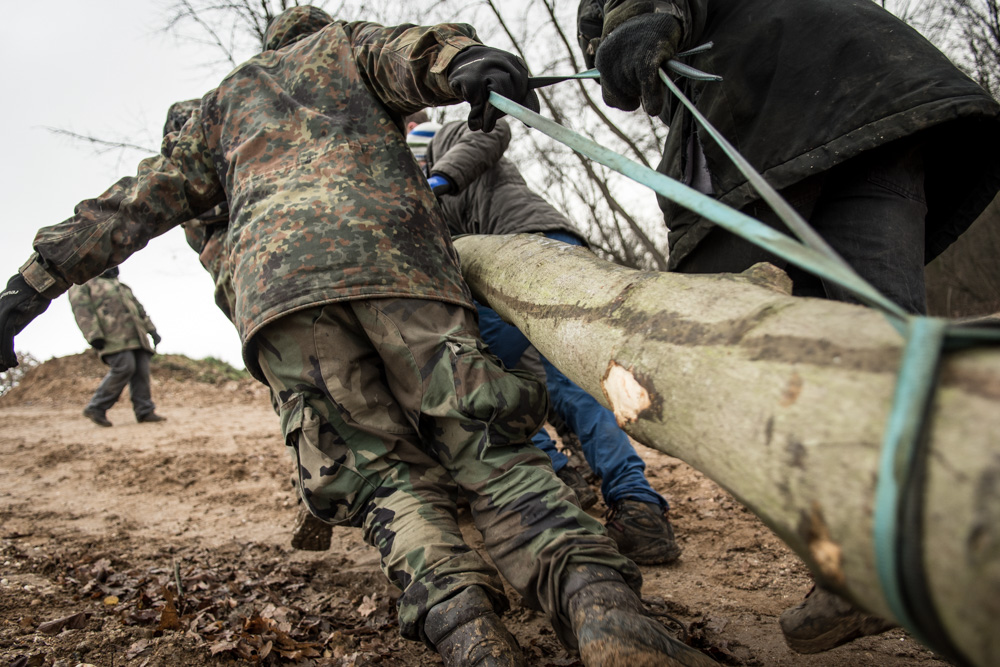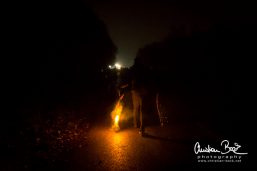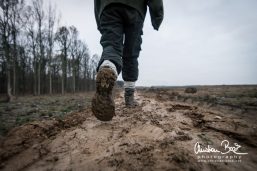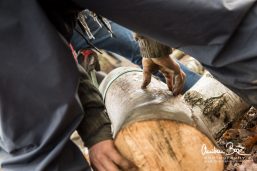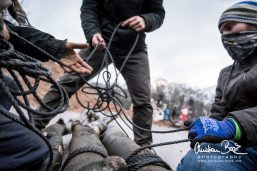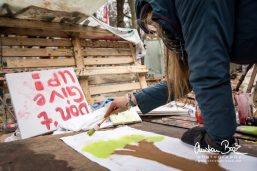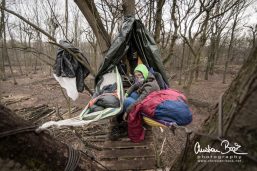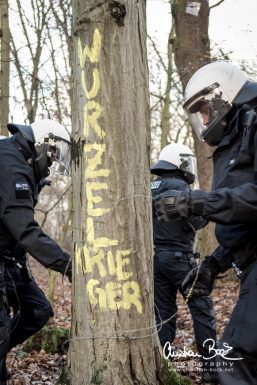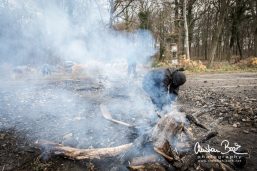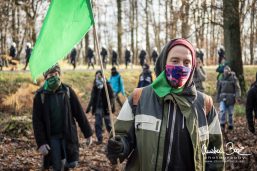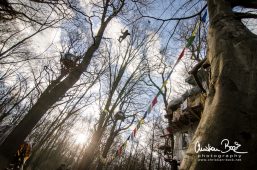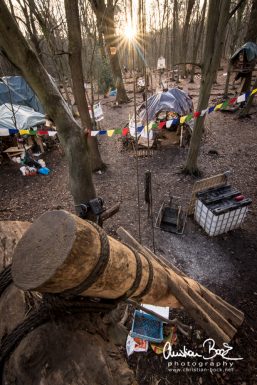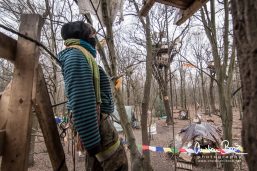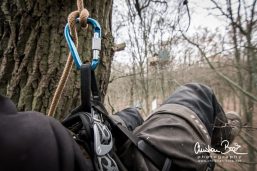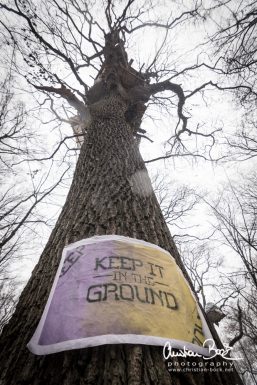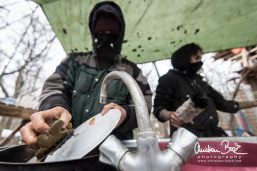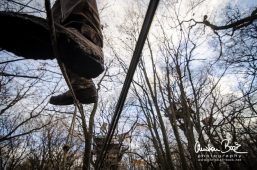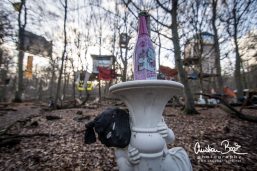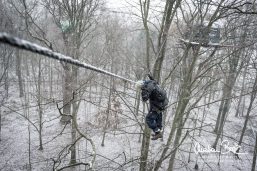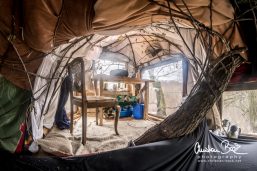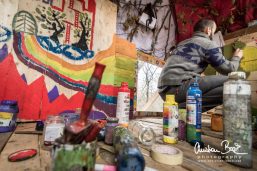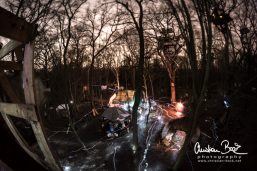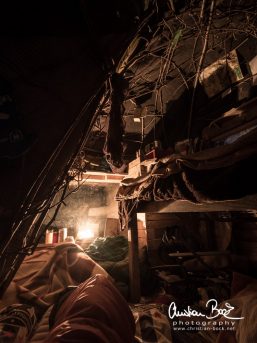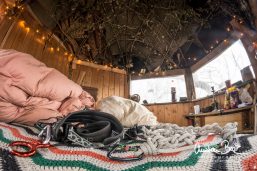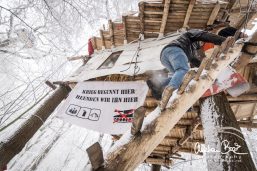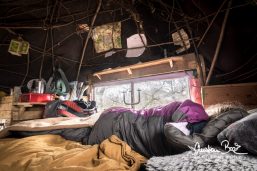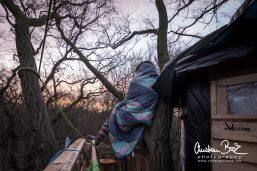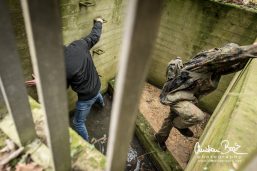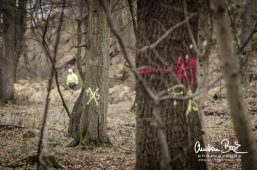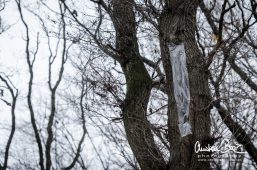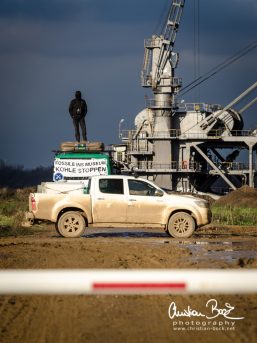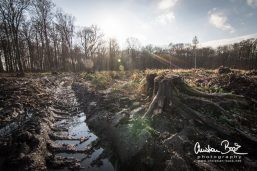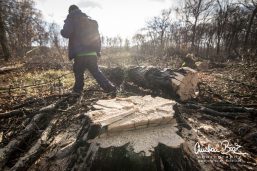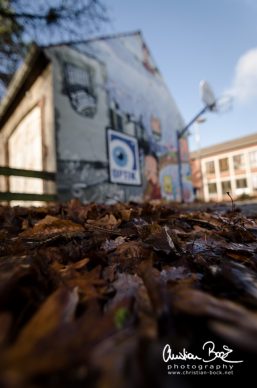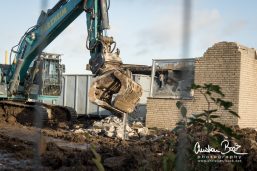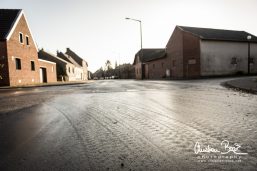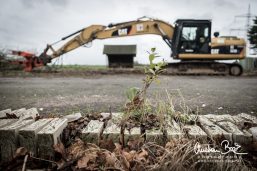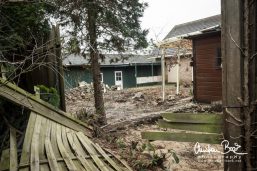(Remark: In case people are unmasked, due to legal issues their faces are omitted or made unrecognizable in the pictures).
A hard core of 50-200 courageous people has dedicated parts of their lifes to protect an ancient German forest and prevent the adjacent lignite coal-mine to be expanded. The Hambach Forest between Cologne and Aachen in North Rhine-Westphalia was originally 5500ha in area, the largest in the Rhineland. Now, due to the ongoing expansion of the mine over the last decades, only 200ha are left and are due to be cleared as well by the German power corporation RWE. In autumn 2017, I spent two months in the forest and accompanied the activists in their daily lifes.
Introduction: Perspectives on political incompetence
for Nature cannot be fooled.
(Richard P. Feynman, theoretical physicist and Nobel laureate)
Science is the human project of describing the world in objective facts. Established scientific facts like the existence and effects of gravitation, the behavior of a charged particle in a magnetic field or the interaction of solar radiation with molecules like carbon dioxide or methane, have fundamentally a different character than (political) opinions. Once established and reproduced in numerous ways, scientific facts are not something you can argue about. Rejecting them – depending on the decisions made – could have far reaching consequences that are hugely unfavorable.
If humans would be purely rational beings, they would act according to the scientific predictions in order to avoid misery in the future. If not for single individuals, but at least for governments one might think that decision-making should be a rather rational process and that state officials in western countries do actually listen to what their scientific panels are telling them. As a matter of fact, this doesn’t seem to be the case, as otherwise we would have slowly transitioned to renewable energies over the course of the second half of the 20th century and the economy in western countries might be more or less de-carbonized already. As of 2017, it’s too late for such a slow transition. We have to act fast to prevent the worst. Still – Germany is expanding its coal-mines.
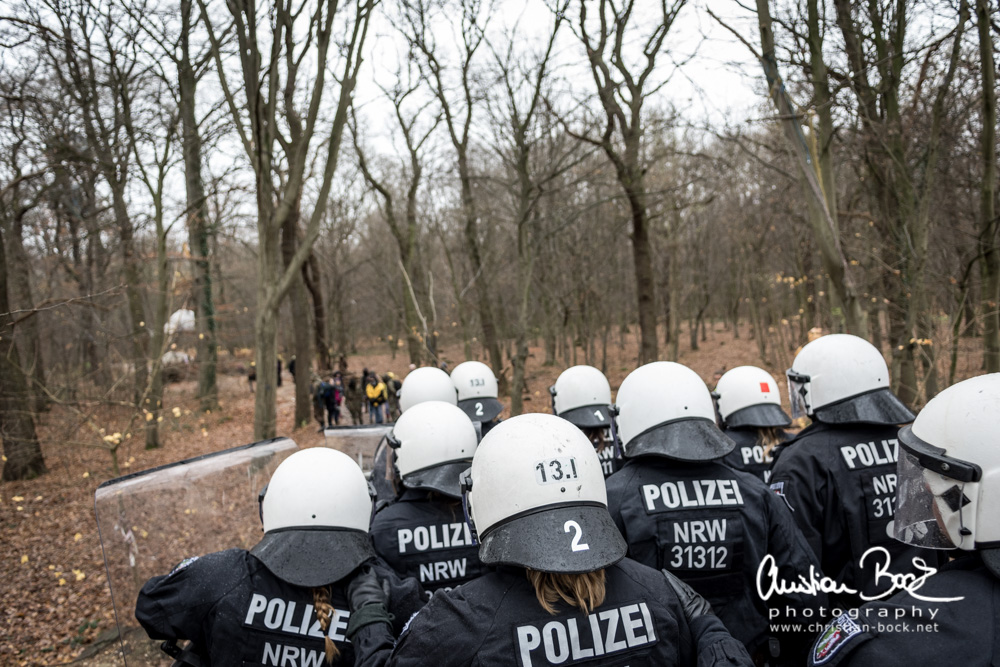 First day of the cleaning in autumn 2017. Police approaching the barricades at the entrance of the occupied part of the forest.
First day of the cleaning in autumn 2017. Police approaching the barricades at the entrance of the occupied part of the forest.
To underline the incompetence of the political decisions made in the last decades, among many other scientific works, I consider here the results of a paper by Mora et al which was published in 2017 in the Journal “Nature Climate Change”. In the research article “Global risk of deadly heat“1, the scientists arrive at the results shown in the graphic below.
The RCPs (Representative Concentration Pathways), as adobted by the IPCCs 5th Assesment Report2, describe different development-scenarios of greenhouse gas emissions in the future. RCP2.6 refers to a scenario that “aims to keep global warming likely below 2°C above pre-industrial temperatures”3 – which represents the 2°C target of the Paris agreement. This appears to be a very tough to reach goal though, if not an unrealistic one by current outlooks4. RCP6.0 to RCP8.5 depict “business as usual”-scenarios, that means we continue burning fossil fuels more or less the way we are doing it now, not taking any stringent mitigation actions.
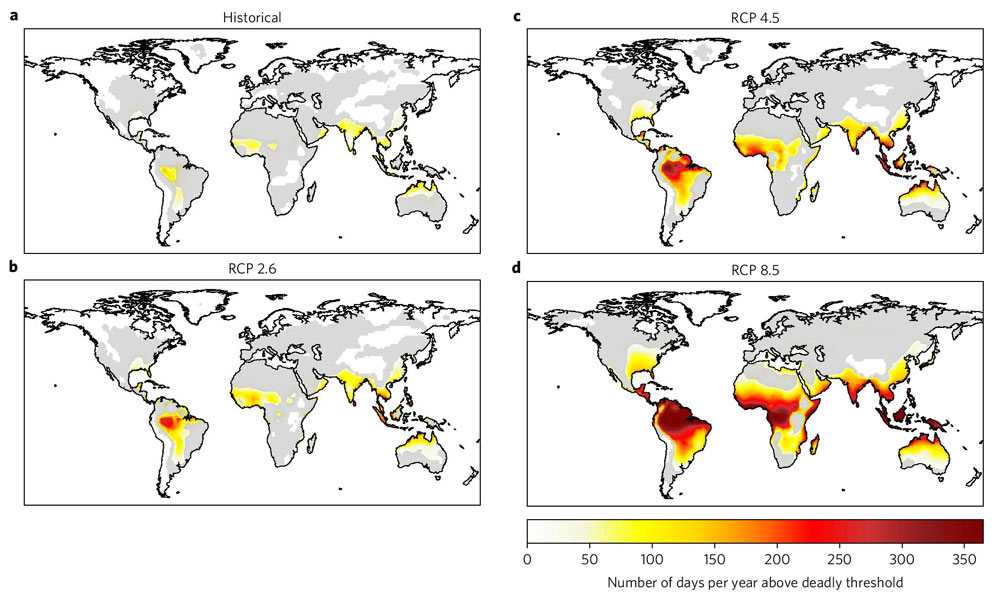 Global risk of deadly heat, Mora et al, Nature Climate Change, Volume 7, July 2017
Global risk of deadly heat, Mora et al, Nature Climate Change, Volume 7, July 2017
The graphic shows the number of days over the year when conditions are lethal for human beings under the different RCP-scenarios. There are physical borders to the bodies’ ability to maintain 37°C in the core, which is depending on the outside temperature and humidity. Above certain thresholds – as for many mammals – sweating becomes ineffective at dissipating heat. For RCP8.5 (“business as usual”), the areas around the equator are projected to become practically uninhabitable, since more than 350 days of the year the conditions will exceed human thermoregulatory capacity. Keep in mind here that at least the predictions of the IPCC are considered to be conservative and many of the actually measured effects are exceeding the forecasts in its severity and pace of progression5.
In the light of scientific predictions like this, by continuing mining the most GHG-polluting fossil fuel we know of – lignite coal – the German government and RWE are knowingly risking to create a largely uninhabitable planet for humans. I don’t claim that they consciously aim for an outcome like this, but since in this decade-long debate and fight they were constantly presented with the facts by scientists, any decisions made to prolong the life of this industry embodies political incompetence. This is especially true if you compare the situation to countries like Sweden which since the 1970s have managed to already largely put into place what is necessary to tackle the problem.6
1 Global risk of deadly heat, Camilo Mora et al, Nature Climate Change, Volume 7, Pages 501–506 (2017)
2 IPCC, 5th Assessment Report (AR5)
3 IPCC, Climate Change 2014, Synthesis Report, Page 8, SPM 2. Future Climate Changes, Risks and Impacts
4 Is the 2 °C world a fantasy?, Jeff Tollefson, Nature News Feature, 24 November 2015
5 Brysse, K., et al., Climate change prediction: Erring on the side of least drama? Global Environ. Change (2012)
6 Raymond Pierrehumbert, How to decarbonize? Look to Sweden, Bulletin of the Atomic Scientists, Volume 72, 2016, Pages 105-111, 2nd March 2016
Resistance and Conflict
Since 2012, parts of the forest are occupied by activists from all over the world. From the very beginning, the occupation was subject to (complete) evictions by the police nearly every year. But continuously people came back to fight again and again the expansion of the mine and the destruction of the forest. The conflicts usually concentrate in the cutting-season, which starts in autumn. The German power corporation RWE every year is making use of their governmentally granted rights of destroying the forest and digging for the lignite coal underneath it.
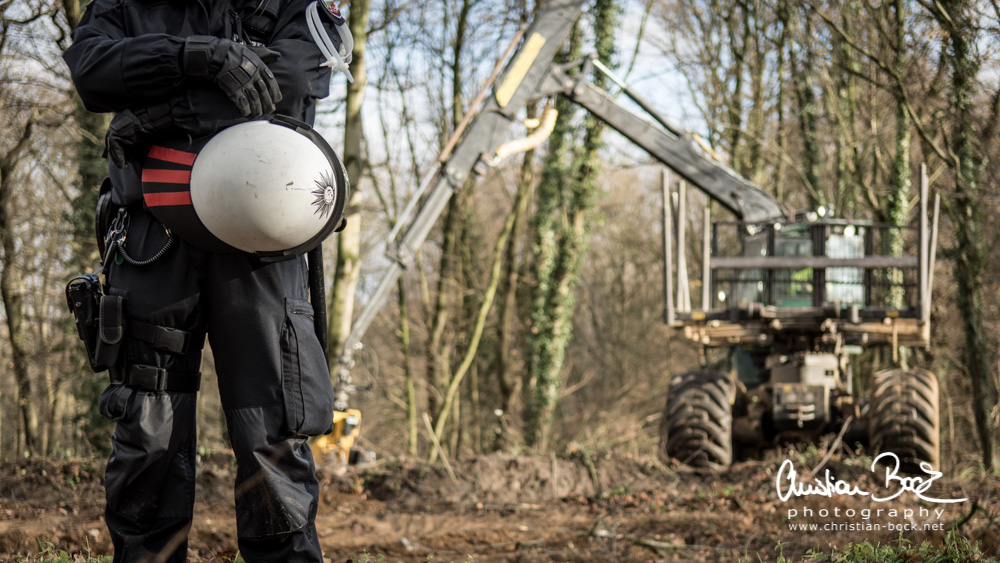 Police shielding the workers and machinery from activists and protestors.
Police shielding the workers and machinery from activists and protestors.
Especially with the use of modern media and internet, the occupation became strongly interconnected with people all over the world. At times of the cutting-season or immediate dangers of evictions, the occupiers may quickly mobilize hundreds and thousands of people to directly support them physically in the forest, by solidarity announcements in the media or donations. Still, the pressure is huge every year and anyone actually coming into the forest to help is very appreciated by the community. For current information on the situation visit hambachforest.org or follow on Twitter @HambiBleibt.
Indeed, many prominent scientists like the former director of NASA, James Hansen in the US or the renowned physicsist Harald Lesch in Germany endorse massive civil disobedience, or at least mass-strikes. After all the fights science has led with rational arguments, the clock has approached a time when governments seemingly have to be forced to take large-scale action to prevent the worst from happening.
In terms of direct action, the community seems to be split into two parties. The large majority of the occupiers have a basically very peaceful attitude and follow the codex of non-violent resistance. In fact, what is often overseen by the media, is that most people are not just coming into the forest to protest against the expansion of the lignite mine. A large part of the year this place is about community, living together and trying to build a place of alternative ways of existence. In my perception it also could be seen as a sphere of educating and “exercising” people towards a reductionist life-style of low ecological footprint. Although this way of life might be repelling for many at first, there is a a tremendous amount of knowledge shared among the people in the forest, that one could learn a lot of to at least take certain provisions of diminishing the use of resources in ones own life.
There is a much smaller group of individuals who – compared to the large majority – tends to follow a more “progressive” style of resistance. In general this diversity of approaches might be considered as fruitful, since the actions tend to be dynamic and hard to predict from outside (especially by police-forces and RWE security). This makes the occupation less vulnerable and possibly more effective. On the other hand though, the anarchic structure might create occasions where single individuals create situations by their actions, which from a large-scale perspective are strategically unfavorable and may unnecessarily risk the occupation as a whole. This also reflects in the very different motives why people are there. They range from a mere resistance against coal-power and activism in the context of climate change and environmental protection, to living an anarchist life-style and experimenting to create a different society as a whole.
Community
Although due to the anarchic concept there is no structure or something like dedicated “leaders”, the organizational background and functioning of the resistance is quite impressive. Food, water, electricity, heating, sleeping-places, building material, climbing equipment, media-responses and interviews etc. have to be organized on a day-to-day basis on behalf of hundreds of people. A massive task that is solved in small autonomous entities that are connected with each other all over the forest.
As mentioned above, many people come to the forest not just because of resistance to coal infrastructure, they come into the woods because they also want to exercise a different way of life. Over the years this place has become much more than an occupation of activists. By now, a hard core of people actually live there nearly year-round. The tree-houses were built with a lot of ambition, energy and time. A possible eviction that would destroy the buildings would be like taking down their homes.
The occupation is mostly very welcomed by the locals living around the mine. The most important support of the community in the forest is originating from civilian groups in the area who oppose the mining as well. Without this large network, the occupation would be much more difficult to entertain. A prominent occasion of creating public awareness for the problems is the weekly “Waldspaziergang” (Walk through the forest), organized by the nature guide Michael Zobel (naturfuehrung.com). Hundreds of people gather each month to visit the forest and the occupation. They also have a look at the destruction of the adjacent mine, learn about the ecosystem of the woods and the challenges this place faces. During acute times of conflict the presence of outside supporters, civilians, activists and the media is enormous. The resistance may in the end always sit on the shorter lever than RWE and the German government, but the huge attention it gets via the media is an important motor to bring climate change and related issues into the news and peoples’ minds. Nowadays the Hambach Forest Occupation may be regarded as the symbol of the German anti-coal movement and plays a vital role in creating public awareness globally.
Living in the Trees
The tree-houses are as diverse in style and interiors, as the people who inhabit them. Most of the dwellings are constructed very high up in the oaks and beeches. They can only be reached by climbing up ropes or by traverses from other tree-houses. Rarely, bigger communal houses are built near the ground, which may also be reached via staircases or ladders. Apart from actual tree-houses, there are a multitude of platforms that merely resemble flat surfaces hanging high up in the crowns. They provide more space for the occupation on other trees in case of an eviction. The major materials used are old building wood and often palettes. Remarkable is the way the houses are actually connected to the trees: in the whole forest no single screw or nail was used for joining the buildings to the stems. It is all held together by polypropylene ropes and knots – which requires quite some craftsmanship and creativity.
The interiors range from very simple covers to multi-floor “apartments” with solar electricity, ovens and kitchens. Depending on the size, the dwellings may house multiple people. Some are beautifully crafted and, given the conditions in terms of materials used and requirements of an occupational life, might be even considered works of art.
Legal fights with bats and properties
There is something peculiar you notice while strolling through the forest. A lot of trees are marked on their stems with codes like “F157”, “F78” and so forth. According to the activists, RWE hired biologists to find possible nesting sites of the Bechstein’s’ Bat in the woods. The animals need for their reproducation old oaks and beeches that are partly already dead. The Hambach forest is one of the rare places left in Europe that provides a habitat for the bat and where the animal was actually observed. The bat is under environmental protection by law of the European Union. Proving the existence of the bat in the Hambach Forest is one of the legal ways how the BUND (Friends of the Earth Germany) is trying to stop the cutting at court and (also for numerous other reasons) pushing forward to it actually becomming a conservation area. The accusation goes that RWE tried to forcefully “resettle” the animals in order to escape this possibility, by finding potential nesting holes in the trees and closing them with plastic (see pictures below). The bats then either cannot move in there for breeding or if they already inhabit the place, they’d starve.
In the beginning of the clearing season in 2018, the high administrative court of Munster actually stopped the ongoing eviction of the occupation and the cutting by accepting a lawsuit by the Friends of the Earth Germany, that claims the existence of the Bechstein’s bat in the forest. This argument of the BUND has already been rejected twice before by the court. It seems like that this time the huge public pressure during the violent eviction process in autumn 2018 did its part in this decision. But the further clearing is only prohibited til the main trial brings a decision in this case.
Another legal and clever way the Friends of the Earth Germany are trying to prevent the expansion of the mine is a piece of land they bought long ago. It’s surrounded by private property of RWE that is due to be destroyed by the coal diggers. This relatively tiny area owned by the NGO though is now directly blocking an expansion in a specific part of the mine.
History becomes history
One of the villages that is currently resettled by RWE due to the expansion of the mine is Manheim, located south-east of the forest and the pit. As of 2017, the locals are already mostly gone. The government though uses the empty houses as intermediate dwellings for refugees. The stories of the people that have been moved don’t sound very positive. If you are not willing to cooperate from the very beginning, people are indirectly pushed from their property by being offered less and less money each year for rebuilding the house at the new site (Manheim-neu). Those might be modern and great dwellings, the money and material obviously cannot substitute though for the emotional bonds that people have to the place they grew up in, which eventually is going to completely disappear. Nor can they reconstruct the feeling living in homes that they built with their own hands and families. The psychological pressure increases with the years, since more and more people and infrastructure are leaving the village. Eventually the government may “evict” resisting residents from their own private property.
Manheim is over 1100 years old. Its church “Saint Albanus and Leonhardus” was first mentioned in the year 1356. It will be destroyed together with the school, kindergarten and all the houses that once were homes to more than thousand people, to create space for an enterprise that with its daily business increases the likelihood of making the planet uninhabitable for future generations.
g